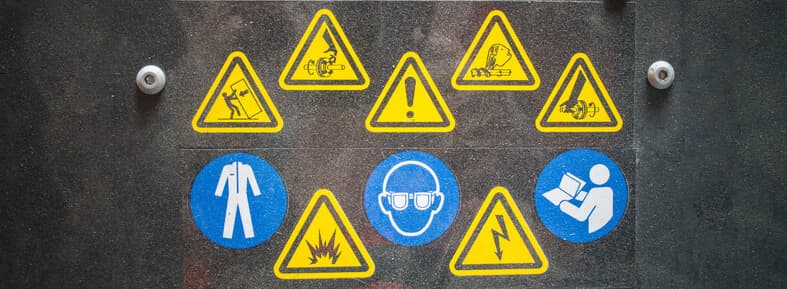Every year, OSHA releases its list of the most common violations, shedding light on areas where businesses may be falling short in maintaining safe working environments. Among these violations, "serious" violations stand out as significant breaches that pose substantial risks to workers' health and safety. However, this article delves into the top "serious" violations identified by OSHA, provides a comparative analysis of violation trends over time, and breaks down the most common types of violations by industry sector.
What is a Serious OSHA Violation?
A Serious OSHA Violation refers to a breach of safety regulations by an employer that could potentially result in severe injury or death to employees. These violations are categorized as serious because they present a significant risk to the health and safety of workers within the workplace. Examples include failure to provide proper fall protection, inadequate machine guarding, or insufficient training on hazardous materials handling. OSHA imposes penalties for serious violations to encourage employers to prioritize safety measures and mitigate risks to their workforce.
6 Major Types of OSHA Violations
Workers' safety is essential, providing a safe working environment worker is the major responsibility of every organization. If employers do not take it seriously it can lead to serious violations. Understanding the types of violations and their associated fines is crucial for maintaining workplace safety and compliance.
Serious Violations
Serious violations are those that pose a substantial probability of death or serious physical harm to employees.
Other-Than-Serious Violation
These violations are not likely to cause death or serious harm, but they still impact workplace safety and health.
De Minimus Violations
Technical OSHA standards violations known as de minimis violations, are those that do not directly affect the safety or health of employees.
Willful Violations
Willful violations happen when an employer purposefully breaks OSHA rules or behaves carelessly toward the security of their workers.
Failure to Abate Violations
If an employer fails to correct a previously cited violation within the specified abatement period, they may face additional fines.
Repeated Violations
Repeated violations refer to violations that are substantially similar to a previous violation, whether at the same workplace or a different one.
Here you read the OSHA violation fines for different serious violations;
|
OSHA Violation Fines |
||
|
OSHA Violations |
Minimum Penalty |
Maximum Penalty |
|
Serious |
$1,116 each violation |
$15,625 for each violation |
|
Other-than-serious |
$0 for each violation |
$15,625 for each violation |
|
Repeated and Willful |
$156,259 |
$15,625 for each violation |
|
Posting Requirements |
$0 for each violation |
$15,625 for each violation |
|
De minimus |
N/A |
$15,625 for each violation |
It's important to note that OSHA fines are subject to adjustment based on factors such as the size of the employer, the gravity of the violation, the employer's history of violations, and good faith efforts to comply with OSHA standards. Employers should prioritize workplace safety to avoid OSHA violations and ensure the well-being of their employees.
10 OSHA Violations Frequently Filed & How to Avoid Them
To maintain a safe work environment and comply with OSHA regulations, employers must understand common violations and take proactive measures to prevent them. The following list outlines the top 10 most frequently cited OSHA violations;
OSHA violation #1 – Fall Protection (General Requirements)
Fall protection violations are among the most common citations issued by OSHA. Employers often fail to provide adequate fall protection systems, such as guardrails, safety nets, or personal fall arrest systems, for employees working at heights.
Prevention Tips
To prevent such violations, employers should conduct thorough assessments of work areas to identify fall hazards and implement appropriate measures to control risks. This includes providing proper training to employees on how to use fall protection equipment correctly and ensuring regular inspections and maintenance of fall protection systems.
OSHA violation #2 – Hazard Communication
Hazard communication violations occur when employers fail to properly communicate chemical hazards in the workplace, including inadequate labeling of hazardous materials and insufficient training for employees on the risks associated with chemical exposure.
Prevention Tips
Employers should develop a comprehensive hazard communication program that includes proper labeling of containers, safety data sheets (SDS) for each hazardous chemical, and employee training on how to recognize and safely handle hazardous substances.
OSHA violation #3 – Ladders
Ladder-related violations often involve issues such as using damaged or defective ladders, improper ladder setup, or failure to provide training on ladder safety.
Prevention Tips
Employers must ensure that ladders are inspected regularly for defects, stored properly when not used, and used only for their intended purposes. Additionally, employees should be trained on proper ladder usage, including how to inspect a ladder before use, maintain three points of contact while climbing, and avoid overreaching.
OSHA violation #4 – Scaffolding
Scaffolding issues usually happen because the scaffolds are not built properly, workers don't have enough safety gear to prevent falls, or no one checks the scaffolds regularly.
Prevention Tips
To stop these problems, employers should make sure only trained people put up and take down the scaffolds, following the rules from the scaffold maker and OSHA. It's also important to have someone who knows what they're doing check the scaffolds often. Workers should be taught how to stay safe on scaffolds and use safety equipment to avoid falls.
OSHA violation #5 – Powered Industrial Trucks
Powered industrial truck violations involve issues such as inadequate operator training, failure to conduct regular inspections of equipment or improper use of powered industrial trucks.
Prevention Tips
Employers must make sure that only trained and authorized employees operate powered industrial trucks, conduct regular inspections and maintenance of equipment, and enforce safe operating practices, such as obeying speed limits and using seat belts.
OSHA violation #6 – Lockout/Tagout
Lockout/tagout violations happen when bosses don't follow the right steps to keep workers safe from dangerous energy while fixing or servicing equipment. This might be because employees aren't trained enough, there aren't clear instructions written down, or nobody checks regularly if safety procedures are being followed.
Prevention Tips
Supervisors and managers need to design a comprehensive lockout/tagout strategy to prevent these issues. This strategy should contain explicit instructions for securing and labeling equipment, in-depth training for authorized personnel, and routine inspections to ensure that everyone is abiding by the guidelines.
OSHA violation #7 – Respiratory Protection
Respiratory protection violations occur when employers fail to provide adequate respiratory protection for employees working in environments with airborne contaminants. This can include issues such as not conducting proper fit testing for respirators, failing to provide appropriate respirator training, or neglecting to develop a written respiratory protection program.
Prevention Tips
It is the employer's responsibility to do a thorough assessment of a workplace to determine the need for respiratory protection, select appropriate respirators for the hazards present, and ensure that employees are trained on how to use and maintain their respirators properly.
OSHA violation #8 – Eye and Face Protection
Eye and face protection violations occur when employers fail to provide appropriate eye and face protection for employees working in environments with potential eye or face hazards. This can include issues such as not providing protective eyewear, inadequate training on the proper use of eye and face protection, or failure to conduct hazard assessments to identify potential risks.
Prevention Tips
Employers should identify potential risks to the eyes and face at work, offer appropriate protective gear, and make sure staff members are instructed on when and how to use it appropriately to prevent these infractions.
OSHA violation #9 – Electrical – Wiring Methods
Electrical wiring method violations occur when employers fail to comply with OSHA standards for the installation and use of electrical wiring systems, including issues such as exposed wiring, improper grounding, or the use of damaged electrical equipment.
Prevention Tips
Employers must make sure that electrical installations are carried out by trained professionals and other pertinent regulations to avoid these infractions. Staff should be instructed in safe work procedures when working with or near electrical equipment. Regular inspections of electrical systems should also be carried out to find and fix any possible dangers.
OSHA violation #10 – Machine Guarding
Violations related to machine guarding occur when employers don't give the right protection to machinery, leaving employees exposed to dangerous moving parts.
Prevention Tips
Employers need to thoroughly check machinery for any dangers and put in place suitable guards or protective devices to lower the risks. Employees should be taught why machine guarding is important, including how to spot and report problems with guards or protective devices, and how to operate machinery safely.
Comparative Analysis of OSHA Violation Trends Over Time
To understand how OSHA violation trends have evolved over time, it is essential to analyze data from previous years and identify any patterns or changes. A comparative analysis reveals fluctuations in the prevalence of certain violations, shifts in enforcement focus, and the effectiveness of OSHA's initiatives in improving workplace safety.
For example, comparing violation data from the past decade may show a gradual decrease in certain violations due to increased awareness and compliance efforts within specific industries. Conversely, emerging technologies or changes in work practices could lead to new types of violations requiring targeted intervention from OSHA.
Breakdown of the Most Common Types of Violations by Industry Sector
Different industries face unique safety challenges based on the nature of their operations, the type of hazards present, and the workforce demographics. Analyzing OSHA violation data by industry sector allows for a tailored approach to addressing prevalent safety issues and implementing effective preventive measures.
Construction
The construction industry consistently ranks among the top sectors for OSHA violations due to the inherent risks associated with activities such as working at heights, operating heavy machinery, and handling hazardous materials. Common violations in construction include fall protection, scaffolding safety, and electrical hazards.
Manufacturing
Manufacturing facilities encompass a wide range of processes involving machinery, chemicals, and materials, making them susceptible to violations related to machine guarding, hazard communication, and lockout/tagout procedures. OSHA focuses on promoting safety protocols to mitigate the risks of workplace accidents in manufacturing settings.
Healthcare
The healthcare sector faces unique safety challenges, including exposure to biological hazards, ergonomic risks, and workplace violence. OSHA violations in healthcare often involve inadequate infection control measures, improper handling of hazardous drugs, and deficiencies in ergonomic practices to prevent musculoskeletal injuries among healthcare workers.
Bottom Line
Once the understanding of the top 10 OSHA violations frequently filed and implementing proactive measures addressed properly then, employers can significantly enhance workplace safety and compliance with OSHA regulations. Investing in comprehensive safety programs, employee training, and regular inspections not only protects workers from harm but also helps businesses avoid costly fines and legal consequences associated with OSHA violations. Prioritizing safety in the workplace is essential for fostering a culture of health and well-being for employees while ensuring business continuity and success.


